
The Sipuncula or Sipunculida is a group containing about 162 species of bilaterally symmetrical, unsegmented marine worms. The name Sipuncula is from the genus name Sipunculus, and comes from the Latin siphunculus meaning a "small tube". Traditionally considered a phylum, Sipuncula seems to be closely related to Myzostomida and Annelida, and may be a subgroup of Annelida, based on recent molecular work. Sipunculans vary in size but most species are under 10 cm (4 in) in length.

Onychophora, commonly known as velvet worms or more ambiguously as peripatus, is a phylum of elongate, soft-bodied, many-legged panarthropods. In appearance they have variously been compared to worms with legs, caterpillars, and slugs. They prey upon smaller animals such as insects, which they catch by squirting an adhesive slime.

The rotifers, commonly called wheel animals or wheel animalcules, make up a phylum (Rotifera) of microscopic and near-microscopic pseudocoelomate animals.

The Anomalocaridids comprise a group of very early marine animals known primarily from fossils found in Cambrian deposits in China, United States, Canada, Poland and Australia. They were long thought to be restricted to this Cambrian time range, but the discovery of large Ordovician specimens has extended this somewhat. The later Devonian Schinderhannes shows many anomalocaridid features. Although originally interpreted as an anomalocaridid-like arthropod, some recent studies suggest that it may represent an anomalocaridid: if so it would extend the group's record by some hundred million years: the non-mineralised anomalocaridid structure means they are absent from the intermediate fossil record.

The mountain zebra is a species in the family Equidae.

The Heleophrynidae are a family of order Anura, commonly known as ghost frogs. The family consists of two genera, Heleophryne and Hadromophryne, with seven species. Ghost frogs live in swift-moving mountain streams in South Africa. The common name of "ghost frogs" may have been coined because of their occurrence in Skeleton Gorge.
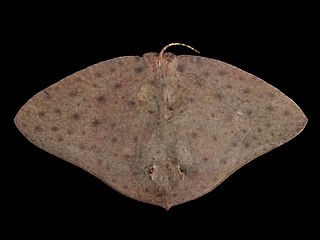
The butterfly rays are the rays forming the genus Gymnura and the family Gymnuridae. They are found in warm oceans worldwide, and occasionally in estuaries.

The Terebellidae is a marine family of Polychaete worms, of which the type taxon is Terebella, described by Linnaeus in 1767.

The tiger catshark is a species of catshark, belonging to the family Scyliorhinidae. It is found over sandy areas and near reef peripheries off South Africa and perhaps Mozambique, from close to shore to usually no deeper than 100 m (330 ft). Reaching a length of 50 cm (20 in), this small, slim shark has a broad, flattened head with an upturned snout tip. It can additionally be identified by its dorsal colour pattern of ten dark brown saddles on a yellowish brown background.
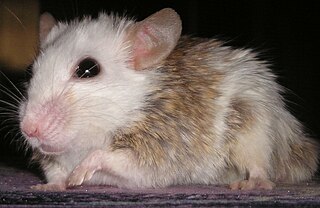
Mastomys is a genus of rodent in the family Muridae endemic to Africa. It contains these species:

Muennink's spiny rat or Okinawa Spiny Rat(Tokudaia muenninki) is a species of rodent in the family Muridae. Endemic to Okinawa Island, Japan, its natural habitat is subtropical moist broadleaf forest. The karyotype has 2n = 44. Its sex chromosomes are abnormally large, while the other two species in Tokudaia have lost their Y chromosome. It is found only on the northern part of the island, above 300 m.

The Natal hinge-back tortoise, also known as Natal hinge-backed tortoise or Natal hinged tortoise, is a species of tortoise in the family Testudinidae which is restricted to eastern southern Africa to a relatively small area around the borders of Mozambique, South Africa, and Swaziland.

An arthropod is an invertebrate animal having an exoskeleton, a segmented body, and paired jointed appendages. Arthropods form the phylum Euarthropoda, which includes insects, arachnids, myriapods, and crustaceans. The term Arthropoda as originally proposed refers to a proposed grouping of Euarthropods and the phylum Onychophora. Arthropods are characterized by their jointed limbs and cuticle made of chitin, often mineralised with calcium carbonate. The arthropod body plan consists of segments, each with a pair of appendages. The rigid cuticle inhibits growth, so arthropods replace it periodically by moulting. Arthopods are bilaterally symmetrical and their body possesses an external skeleton. Some species have wings.
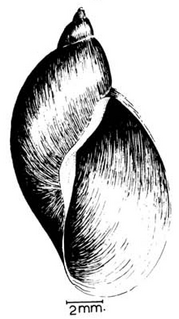
Radix natalensis is a species of freshwater snail, an aquatic gastropod mollusc in the family Lymnaeidae.

Phyllodoce is a genus of polychaete worms, which contains about 200 species. The prostomium bears eyes, two pairs of antennae and a pair of large retractile nuchal organs. The eversible proboscis is clearly divided into two parts.
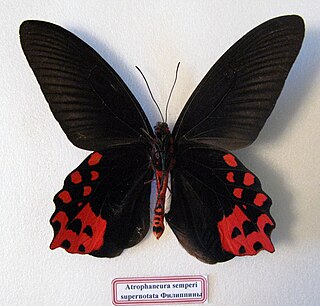
Atrophaneura semperi is a species of butterfly from the family Papilionidae that is found in Indonesia, Malaysia, and the Philippines. It is the type species for the genus.
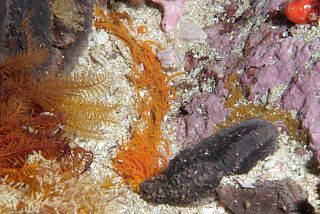
Cirriformia is a genus of marine polychaete worms in the family Cirratulidae.

Phyllodocidae is a family of polychaete worms. Worms in this family live on the seabed and may burrow under the sediment.
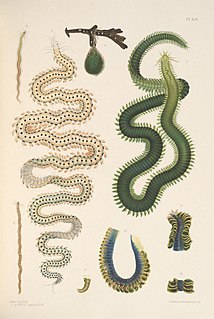
Eulalia is a genus of polychaete worms.


















